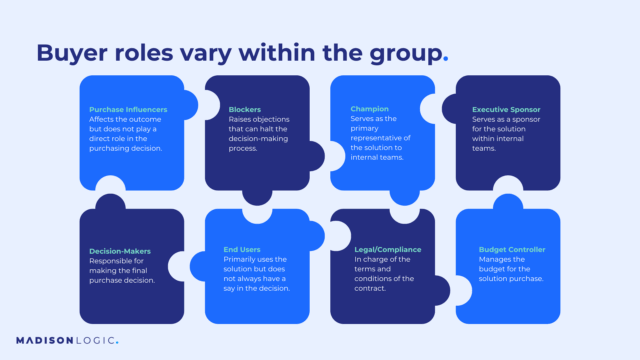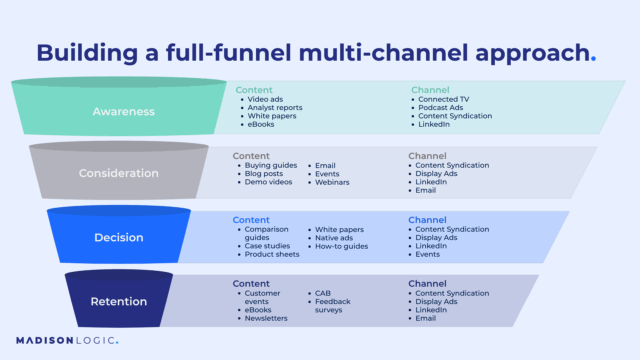
Unlock Global ABM at Scale — Madison Logic strengthens ABM reach with Connected TV and Audio expansion globally. Learn More
Unlock Global ABM at Scale — Madison Logic strengthens ABM reach with Connected TV and Audio expansion globally. Learn More

B2B marketing isn’t just about showcasing what you offer—it’s about how you connect.
Today’s B2B buyers are in control. They do more research, they explore options, and they expect relevant, timely, personalized content that speaks directly to them. In fact, B2B is starting to look a lot like B2C: According to a survey by The Harris Poll and Madison Logic, 64% of B2B marketers say they plan to take a B2C approach in the coming year.
Buyers want connection. They want experiences that feel tailored, not just another value prop.
That’s why a killer ABM content strategy matters more than ever. It’s how you meet buyers where they are, speak to what they care about, and guide them with highly personalized and relevant content. Here are five practices to help you personalize content and create real connection in your next account-based marketing (ABM) campaign.
Research from Gartner shows that meaningful B2B buyer personalization boosts the chances of a high-quality purchase by 9%. But delivering a personalized customer experience means more than just using a {first_name} in an email. It requires a deep, data-driven understanding of your audience that surfaces:
To achieve this level of insight, marketers need to move beyond intuition and surface-level metrics (like website views, open rates, impressions, or followers) and instead embrace intent signals, behavioral data, and internal knowledge. This starts with combining multiple quality data sources to identify not just the right accounts, but the right buyers within those accounts.
Use data sources like:
Together, these signals paint a complete picture of buyer behavior and help personalize content by persona and stage. But true personalization doesn’t stop at identifying one or two individuals. Today’s B2B purchases are made by buying committees, often made up of diverse stakeholders across roles and departments. That’s why it’s critical to speak to the entire buying group, not just a single decision-maker. Personalization must address the distinct motivations, pain points, and priorities of influencers, users, technical evaluators, and executive sponsors alike.

This level of tailored ABM engagement might sound complex, but artificial intelligence tools and marketing automation make it scalable. When used correctly, these ABM tools enable you to:
The result? A coordinated, killer content experience that meets buyers where they are—and moves them closer to a high-quality decision. And as Betsy Utley-Marin, Sr. Director of Corporate Communications at Madison Logic emphasizes,

Today’s buyers want content that’s tailored to their specific needs, goals, and stage in the journey—and marketers need to adapt or risk losing influence in the noise of lookalike messaging, generic outreach, and content overload.
According to Forrester Research, nearly 90% of tech decision-makers say it’s important for vendors to provide relevant content at each stage of the buying process. That means your content strategy must evolve from one-size-fits-all to an always-on experience that aligns format, tone, and depth with where the buyer is. As Johanna Shirman, Enterprise ABM Strategist at Madison Logic explains, helping buyers reach a consensus faster depends on your ability to deliver the right content at the right time. When content supports their decision-making process, you don’t just capture attention—you build momentum toward making a decision faster.

To truly influence decisions and build trust, your content must align with what buyers need at each stage of the funnel. Each touchpoint should serve a specific purpose, whether it’s piquing interest, clarifying value, or reinforcing confidence. A buyer stage-specific content orchestration ensures that every asset moves buyers forward with intention and impact.
Here are the buyer stages and how to match marketing content formats and messaging to where buyers are in the process.
Awareness:
Consideration:
Decision:
Retention:
Here’s a quick guide to help you visualize how to map your content across the buying journey (Awareness, Consideration, Decision, Retention):

As you map content to each stage and persona, it’s crucial to track which assets are actually engaging your audience. Monitoring how different personas interact with specific content types at each point in the journey helps you understand what’s working and what isn’t. Use these insights to refine your content mix over time, focusing on high-impact assets and adjusting or replacing those that fall short.
Killer B2B content puts its value front and center—not just on a single channel, but through orchestrated delivery across multiple channels. This is where buying journey intelligence comes into play: connecting content with real-time account activity across channels to create a more personalized buyer experience.
Multi-channel ABM orchestration ensures that email, display ads, content syndication, website interactions, and sales outreach work seamlessly together. This unified approach helps reinforce messaging, meet buyers with the right content at the right time, and guide them through a consistent, personalized experience across touchpoints. But true orchestration goes beyond channel coordination, it requires alignment of systems, signals, and strategy. Here’s how to make it work:
Centralize your data: Connect your CRM, MAP, ABM platform, and analytics tools so buyer activity is captured and visible across teams. This gives you a shared source of truth to inform content and campaign decisions.
Use intent data and engagement signals to trigger content: Leverage buying signals (like website visits, ad clicks, and content downloads) to automatically trigger the right follow-up content or outreach.
Continuously optimize based on insights: Orchestration isn’t one-and-done. Track what content is resonating with which personas at which stages and adjust accordingly.
Here are some of the best channels to use in your marketing mix channel strategy:
Staying ahead of the curve in a rapidly evolving digital landscape involves using emerging marketing channels in your multi-channel ABM strategy. According to a survey from The Harris Poll on behalf of Maidson Logic, B2B marketers are planning to invest more in four key areas in 2025: social media advertising (60%), artificial intelligence [AI] tools (60%), video (53%), and podcast advertising (50%).
Why? Because attention is shifting—and so are buying behaviors. That means going beyond traditional channels. Marketers will need to lean into meeting buyers where they are—on channels they trust and prefer. Keith Turco, CEO of Madison Logic, says, “With millennials and Gen Z increasingly occupying key roles in the B2B buying process, brands must work harder and seek out ways to meet them where they are.”

Reaching the accounts most likely to engage—with the most relevant message possible—is key to driving higher conversion rates and maximizing ROI. That’s exactly what Salesforce set out to do.
Salesforce partnered with Madison Logic to identify key decision-makers on buying committees and their buying behavior. By combining Salesforce’s first-party account data with the ML Insights combined data set, Andrew Ward, Marketing Director for Salesforce Australia and New Zealand and his team were able to drive higher account engagement through orchestrated content and advertising delivered at the right time.
The best account-based marketing campaigns understand that creating personalized content is only half the battle; proving that it drives business outcomes is where the real value lies. In today’s data-driven ABM strategies, success isn’t measured by vanity metrics like clicks or impressions. It’s about how content influences pipeline progression, deal velocity, and revenue impact. To move beyond surface-level insights, marketers must adopt a measurement mindset that connects content performance directly to business growth.
To prove the real impact of your ABM content, focus on strategic metrics and ABM KPIs that connect directly to pipeline performance and revenue. Start with the 3 Vs, a core lens for evaluating how your content drives business outcomes:
Volume can tell you how effective your content is. The higher the number of leads and opportunities in your sales pipeline, the more successful your content strategy is. It reveals that these accounts are taking notice and you’re initiating conversations with your content. If your pipeline numbers are low, you may need to rethink who is in your audience and what they need from your content.
Value reveals how well you’re communicating your brand’s value to the account through your content. If you’re seeing large numbers in your pipeline value, they like what they see and that’s a hint to build upon that content strategy to continue increasing deal sizes.
Velocity shows you how accounts move through the sales cycle, so you can customize your nurture programs, segmentation, and content strategy to accelerate these key accounts faster. Remember, marketing content should be the right message, delivered to the right person, at the right time.
Once you’ve established a baseline using volume, value, and velocity, it’s time to go further in your ABM measurement. Advanced metrics help you connect the dots between content engagement and real business outcomes. These insights allow you to fine-tune your strategy, prove ROI, and continuously improve how you influence buying decisions:
While these metrics offer valuable insight, truly understanding content impact requires tight sales and marketing alignment. That means moving beyond marketing siloed KPIs to define shared success metrics. When both teams are aligned, content becomes a strategic lever for revenue, not just a marketing asset. Regular check-ins and feedback loops keep everyone focused, coordinated, and continuously optimizing their efforts.
Want to dive even deeper into how to do this effectively? Watch our on-demand content strategy webinar, where our experts walk through real examples and practical frameworks for mapping, orchestrating, and measuring ABM content that performs.
B2B buying has changed dramatically over the last decade. To stay relevant, marketers must continually monitor and adapt to shifting behaviors, preferences, and expectations across every stage of the journey. Here are the key marketing trends to keep an eye on:

Staying ahead of these trends isn’t optional—it’s essential to remain relevant and effective in a world where buyers are more empowered than ever.
For great ABM, you need to create a content strategy that not only speaks to your brand’s value proposition but also connects the audience to your brand through personalized customer experiences. To build a killer content strategy that drives ABM success, focus on three key pillars:
Start by auditing your existing content. Does it align with buyer stage, role relevance, and performance metrics? If not, you’re missing opportunities to influence buying group decisions and build trust.
Looking to level up? Madison Logic helps marketers align ABM content with buyer behavior across every stage and channel. Our strategist team has guided some of the fastest-growing companies in shaping high-impact content strategies—and we’re here to help you do the same. Schedule a demo today to get started.